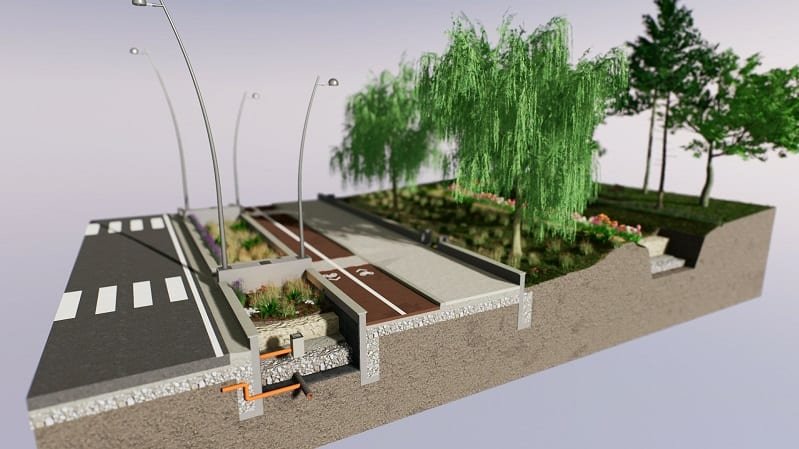Imagine transforming the concrete jungle of an urban environment into a thriving oasis teeming with vibrant flora and fauna. This is the vision behind the creation of sustainable rain gardens in urban areas. These unique gardens not only add beauty to our cities but also serve as a solution to combat stormwater runoff and enhance water quality. By using native plants and specialized design techniques, rain gardens offer an innovative approach to creating a sustainable and ecologically friendly urban landscape.
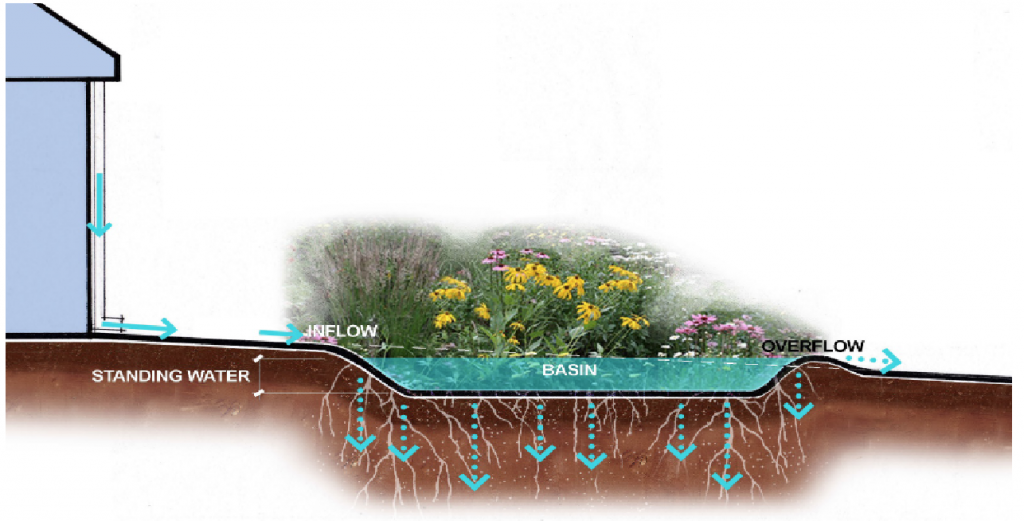
This image is property of extension.okstate.edu.
Benefits of Rain Gardens in Urban Environments
Rain gardens offer numerous benefits to urban environments, making them an effective and sustainable solution for managing stormwater. By incorporating rain gardens into urban landscapes, you can:
Reducing Stormwater Runoff
One of the primary benefits of rain gardens is their ability to reduce stormwater runoff. When it rains, impervious surfaces like roads, parking lots, and buildings prevent water from infiltrating into the ground, causing excess water to flow into storm drains and overwhelm sewer systems. Rain gardens act as natural reservoirs, capturing and absorbing rainfall, allowing it to slowly percolate into the ground. This helps to alleviate pressure on urban infrastructure and prevents localized flooding.
Improving Water Quality
Rain gardens also play a crucial role in improving water quality by filtering and purifying stormwater runoff. As rainwater flows through the garden, the plants, soil, and microorganisms work together to remove pollutants such as sediment, heavy metals, and excess nutrients. This filtration process helps to protect local water bodies, such as rivers and lakes, from contamination, ultimately preserving aquatic ecosystems and ensuring a healthier environment for both humans and wildlife.
Enhancing Biodiversity
Another significant benefit of rain gardens is their ability to enhance biodiversity in urban environments. By incorporating native plant species into rain garden design, you can provide habitat and food sources for a wide range of pollinators, birds, and beneficial insects. This helps to support the local ecosystem and promotes the natural balance of urban biodiversity. Additionally, the diverse range of plant species in rain gardens can create a visually appealing and vibrant landscape, adding aesthetic value to urban areas.
Mitigating Urban Heat Island Effect
Urban areas often suffer from the “heat island effect,” where built-up surfaces like concrete and asphalt absorb and retain heat, creating higher temperatures compared to surrounding rural areas. Rain gardens can help mitigate this effect by providing shade, cooling the surrounding environment, and reducing ambient temperatures through evapotranspiration. By incorporating trees and plants with dense foliage, rain gardens can create a pleasant microclimate, making urban spaces more comfortable and reducing the energy demand for cooling buildings.
Site Selection and Design Considerations
When planning to incorporate rain gardens into urban environments, several key factors need to be considered to ensure the success and functionality of the garden:
Identifying Suitable Locations
To determine suitable locations for rain gardens, assess the topography, soil composition, and existing drainage patterns of the site. Identifying areas prone to stormwater runoff and flooding can help prioritize the installation of rain gardens and maximize their effectiveness. Additionally, considering areas close to impermeable surfaces like rooftops and parking lots can ensure optimal interception and capture of runoff water.
Determining Optimal Size
The size of a rain garden is determined by the amount of runoff it needs to manage. Consider the contributing drainage area and estimate the volume of stormwater that will flow into the garden during rainfall events. It’s essential to ensure that the rain garden is not too small, as it may not be able to handle the volume of water, leading to overflow, nor too large, which can result in insufficient water infiltration.
Assessing Soil Conditions
Understanding soil composition is crucial when designing rain gardens. The soil should have good infiltration capacity to allow water to percolate into the ground. Conducting soil tests to evaluate drainage capabilities, organic content, and compaction levels will help determine if any amendments are necessary to optimize the soil for rain garden construction.
Analyzing Drainage Patterns
Analyzing existing drainage patterns on the site will help determine how water currently flows and accumulates during rainfall events. This information is crucial in determining the most effective location for rain garden placement. By redirecting runoff into the rain garden, you can maximize its ability to capture and absorb stormwater.
Considering Regional Regulations
Before constructing a rain garden, it’s important to research local regulations and obtain any necessary permits. Some areas may have specific guidelines regarding rain garden design, construction, and maintenance. Consulting with local authorities or professional landscape architects can ensure compliance with regulations and help avoid potential setbacks in the implementation process.
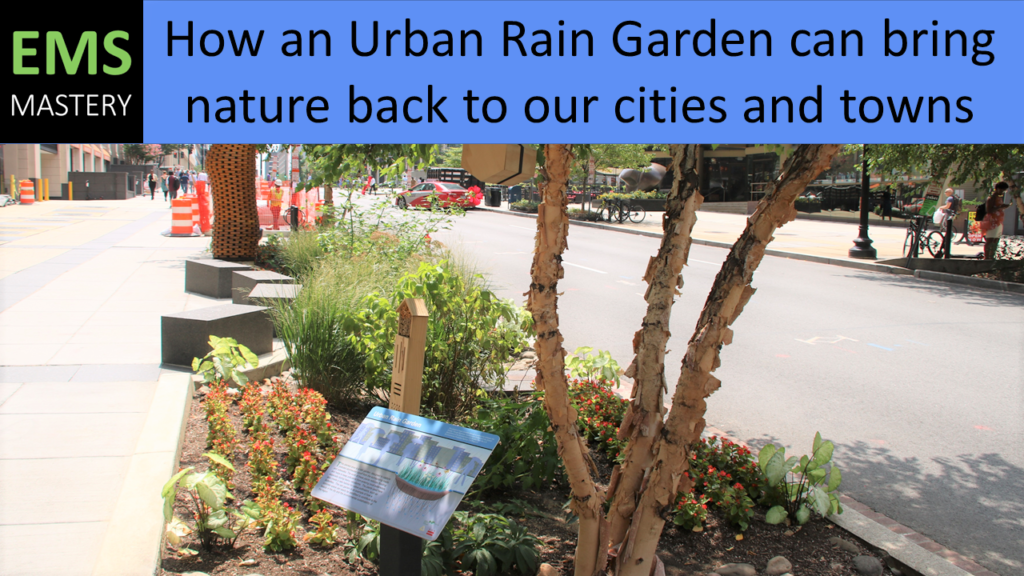
This image is property of i0.wp.com.
Rain Garden Construction Techniques
Building a rain garden involves several key construction techniques to create a functional and sustainable stormwater management system:
Excavation and Soil Preparation
Once the rain garden site has been identified, excavation is required to create the basin or depression that will hold the stormwater. The depth and dimensions of the rain garden will vary depending on the specific design requirements and the volume of runoff it needs to manage. After excavation, the soil should be loosened and prepared to enhance infiltration rates.
Selection of Appropriate Plant Species
Choosing the right plant species is crucial for the success of a rain garden. Native plants are generally preferred as they are adapted to local conditions and require less maintenance. Look for species with deep roots that can improve soil infiltration and stability. Consider incorporating a variety of plants with different heights, bloom times, and root structures to enhance the rain garden’s functionality and aesthetic appeal.
Mulching and Aeration
After planting, applying a layer of organic mulch around the plants is beneficial as it helps retain moisture, suppresses weed growth, and regulates soil temperature. Proper aeration of the soil also aids in water infiltration, preventing compaction and ensuring healthy root growth.
Installation of Perimeter Barriers
To prevent runoff from bypassing the rain garden, the installation of perimeter barriers is necessary. These barriers can be created using materials such as rocks, boulders, or logs, which not only serve a functional purpose but also provide an attractive visual border for the rain garden.
Irrigation Considerations
While rain gardens are designed to capture and retain rainwater, new plantings may require supplemental irrigation during dry spells to establish healthy root systems. Consider incorporating rainwater harvesting systems to collect and store rainwater for future irrigation needs, reducing reliance on municipal water sources.
Managing Stormwater in Rain Gardens
To effectively manage stormwater, it is important to understand the key considerations involved in maintaining rain gardens:
Capturing and Storing Rainwater
Rain gardens are designed to capture and store rainwater, allowing it to slowly infiltrate into the ground. Proper design and construction techniques ensure that the rain garden can hold the necessary volume of water while preventing overflow and flooding.
Infiltration Rate and Overflow Management
Careful attention should be given to the infiltration rate of the soil to prevent standing water and flooding issues. If the soil is slow-draining, additional measures such as underdrains or overflow systems may be necessary to divert excess water. Monitoring and managing the infiltration rate will help maintain the desired water levels in the rain garden.
Maintenance of Desired Water Levels
Maintaining the appropriate water levels in the rain garden is crucial for its functionality and the health of the plants. Regular monitoring is necessary to ensure that the garden is neither under-watered nor over-saturated. If water levels drop too low, supplemental irrigation may be required during dry periods.
Treatment of Runoff Pollutants
Rain gardens help to filter and treat runoff pollutants, reducing their impact on water bodies. However, regular maintenance is required to ensure the effectiveness of this filtration process. Removing accumulated sediment, debris, and excess nutrients from the rain garden will help maintain its ability to treat stormwater runoff.
Preventing Erosion
Erosion can undermine the structural integrity of a rain garden and compromise its functionality. Implementing erosion control measures, such as adding vegetation, installing erosion control blankets, or using rock or mulch revetments, can minimize erosion and ensure the long-term stability of the rain garden.
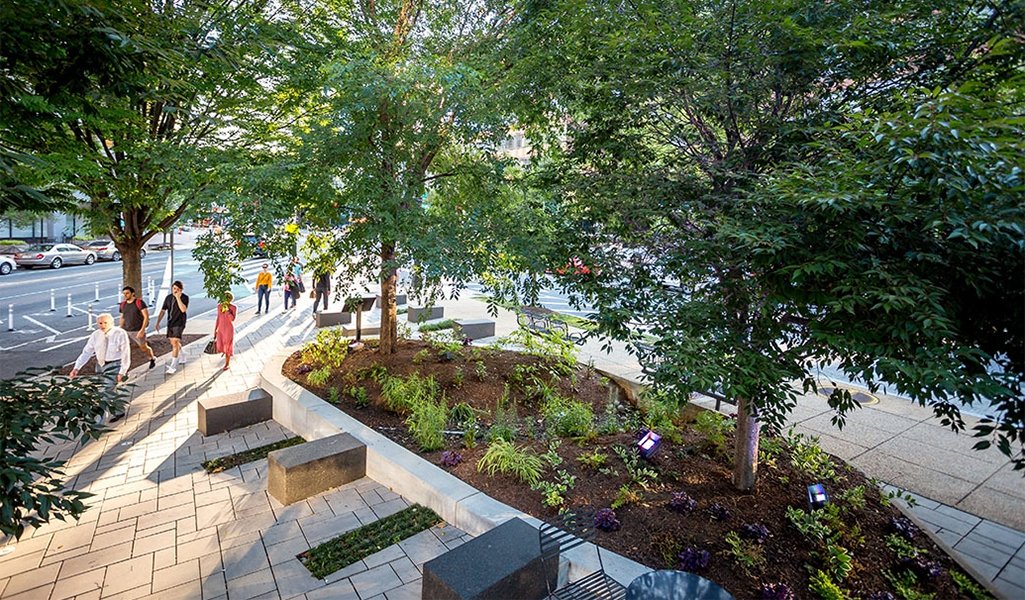
This image is property of earthwatch.org.
Plant Selection for Rain Gardens
Careful plant selection is essential to maximize the benefits of rain gardens. Consider the following factors when choosing plant species for urban rain gardens:
Native Plant Benefits
Native plants are well-suited to local climatic conditions and provide numerous benefits in rain gardens. They have deep roots that help improve soil infiltration, require less maintenance, and provide valuable habitat for native pollinators and wildlife.
Adaptability to Urban Environments
Plants that can tolerate urban environments, such as those that can withstand pollution, high temperatures, and compacted soil, are ideal for rain garden plantings. Select species that have a proven ability to thrive in challenging urban conditions to ensure their long-term viability.
Drought Tolerance
In urban environments where water resources may be limited or subject to water restrictions, it is important to choose plants that are drought-tolerant. These plants can withstand periods of low rainfall and thrive even during dry spells, reducing the need for supplemental irrigation.
Suitability for Different Soil Types
Consider the soil composition in your region and choose plants that are well-suited to the soil types present. Some plants thrive in sandy soils, while others prefer clay or loam. By selecting plants that are adapted to the specific soil types in your rain garden, you can ensure their optimal growth and performance.
Attracting Pollinators
Incorporating plants that attract pollinators, such as bees and butterflies, can enhance biodiversity and ecosystem health in rain gardens. Choose flowering plants that provide nectar and pollen throughout the growing season to support pollinator populations and encourage biodiversity in urban areas.
Maintenance Requirements
To ensure the long-term success and functionality of rain gardens, regular maintenance is necessary. Here are some key maintenance tasks to consider:
Regular Watering and Weeding
Newly established rain gardens may require supplemental watering during dry periods to help plants establish deep root systems. Regular weeding is also necessary to remove invasive species and prevent competition for nutrients and space.
Monitoring Water Levels
Regular monitoring of water levels in the rain garden is essential. Adjustments may be needed to maintain the desired water depth and prevent standing water or excessive drying out. Proper water management ensures the health of the plants and the effectiveness of stormwater management.
Pruning and Deadheading
Pruning and deadheading plants is necessary to encourage healthy growth, maintain plant shape, and promote blooming. Regular pruning helps prevent overcrowding and maintains the desired aesthetics of the rain garden.
Fertilization Needs
In most cases, rain gardens do not require heavy fertilization. However, periodic soil testing can help determine if any nutrient deficiencies exist and guide the appropriate application of fertilizers. Organic fertilizers are generally preferred to minimize environmental impacts.
Pest and Disease Management
Regular inspections for pests, diseases, and invasive species are crucial for maintaining the health of the rain garden. Timely identification and proper management of these issues will help preserve the integrity and functionality of the rain garden.
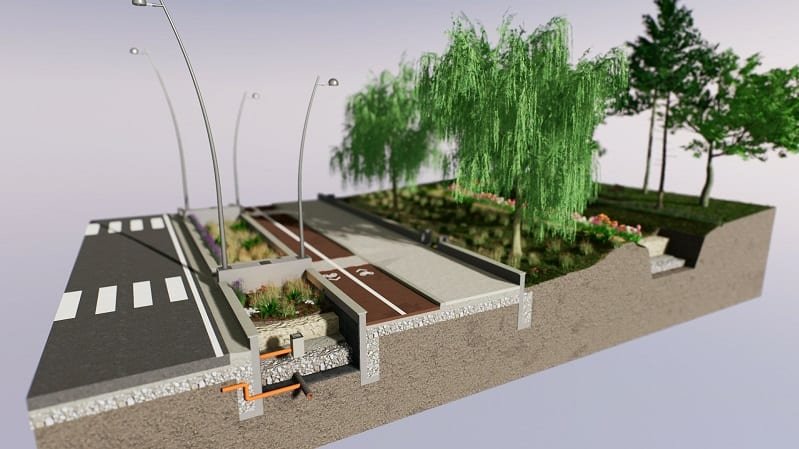
This image is property of biblus.accasoftware.com.
Educating and Engaging Communities
To maximize the benefits of rain gardens in urban environments, it is important to engage and educate the local community. Consider the following strategies:
Raising Awareness about Rain Gardens
Educate the community about the benefits of rain gardens through public awareness campaigns, workshops, and educational materials. Highlight the positive impacts rain gardens can have on stormwater management, water quality, biodiversity, and overall environmental health.
Promoting Community Involvement
Encourage community involvement in rain garden projects. Organize volunteer events where community members can participate in rain garden construction, planting, and maintenance activities. By involving the community, you can foster a sense of ownership and pride in the rain garden, ensuring its long-term care and sustainability.
Collaborating with Local Organizations
Partner with local organizations, such as environmental groups, schools, and community centers, to promote rain garden initiatives. These collaborations can help expand outreach efforts, offer resources and expertise, and encourage community participation.
Providing Educational Resources
Develop and distribute educational resources such as brochures, fact sheets, and online materials to provide practical guidance on rain garden construction, plant selection, and maintenance. These resources can empower community members to create and care for rain gardens on their own properties.
Hosting Workshops and Events
Organize workshops, seminars, and events focused on rain garden design, construction, and maintenance. Offer hands-on training, expert presentations, and demonstrations to educate and inspire community members to incorporate rain gardens into their landscapes.
Overcoming Urban Challenges
Implementing rain gardens in urban environments comes with a unique set of challenges. Here are some strategies for overcoming these challenges:
Limited Space and Land Availability
In densely populated urban areas, finding sufficient space for rain gardens can be a challenge. Explore innovative solutions such as green roofs, rain barrels, or small-scale rain gardens that can be integrated into existing structures to maximize stormwater management within limited space.
Addressing Soil and Contamination Issues
Urban soils are often contaminated with pollutants from various sources. Conduct thorough soil testing to identify contaminants and take appropriate remediation measures if needed. Amend the soil as necessary to improve drainage and enhance its suitability for rain garden plantings.
Dealing with Urban Pollution Sources
Urban environments are rife with pollution sources such as vehicular emissions, industrial activities, and pesticides. Minimize pollution impacts on rain gardens by incorporating pollutant-tolerant plants, implementing runoff filtration systems, and advocating for reductions in local pollution sources.
Integrating Rain Gardens with Existing Infrastructure
When designing rain gardens, it’s crucial to consider existing infrastructure such as underground utilities, drainage systems, and parking areas. Collaboration with city planners, engineers, and utility companies will help ensure that rain gardens are integrated harmoniously into the urban landscape without causing conflicts or disruptions.
Mitigating Potential Conflicts with Utilities
Coordination with utility companies is essential to avoid conflicts during rain garden installation. Considerations should be made for buried utilities such as water lines, gas lines, and electrical infrastructure to ensure the safety and functionality of both rain gardens and utility systems.
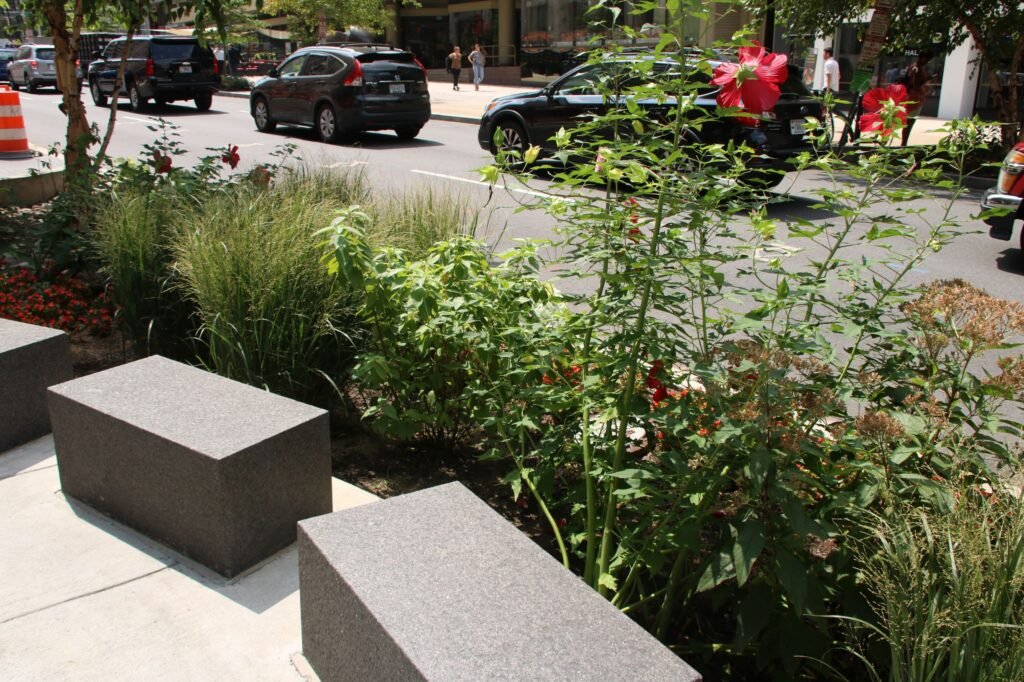
This image is property of i0.wp.com.
Case Studies of Successful Rain Garden Projects
Looking at successful rain garden projects can provide inspiration and guidance for implementing similar initiatives in urban environments. Here are some notable case studies:
Urban Rain Gardens in New York City
New York City has successfully incorporated rain gardens into its urban landscape, particularly in neighborhoods with high risk of stormwater runoff and flooding. These rain gardens have not only effectively managed stormwater but also beautified the city streets, improved air quality, and created community gathering spaces.
Community-led Projects in Seattle
Community-led rain garden projects in Seattle have demonstrated the power of local engagement and collaboration. Residents, nonprofits, and local businesses have come together to transform public spaces, schools, and neighborhoods by implementing rain gardens. These projects have not only provided stormwater management solutions but also fostered community pride and engagement.
Corporate Rain Garden Initiatives
Numerous corporations have embraced rain gardens as part of their sustainable initiatives. These include large corporations like Google and Microsoft, which have implemented rain gardens on their campuses, as well as smaller businesses that have incorporated rain gardens into their landscaping. These initiatives showcase the role of businesses in creating sustainable urban environments.
School and Institution Rain Garden Programs
Schools and universities have embraced rain gardens as educational tools. Rain gardens on campuses provide hands-on learning opportunities for students, teaching them about stormwater management, ecology, and environmental stewardship. These initiatives have created beautiful outdoor classrooms while managing runoff and improving water quality.
Public Park Rain Garden Installations
Municipalities have implemented rain gardens in public parks to manage stormwater runoff and enhance the aesthetics of these green spaces. Rain gardens in public parks provide recreational opportunities while also acting as natural filters to protect nearby water bodies.
Economic and Environmental Benefits of Rain Gardens
Implementing rain gardens in urban environments offers numerous economic and environmental benefits:
Cost-effectiveness of Rain Garden Implementation
Rain gardens provide a cost-effective stormwater management solution compared to traditional infrastructure approaches. The construction and maintenance costs of rain gardens are often lower, and their long-term benefits, such as reduced strain on stormwater infrastructure, mitigate costly flood damages.
Reducing Strain on Stormwater Infrastructure
By capturing and infiltrating rainfall, rain gardens help reduce the strain on traditional stormwater infrastructure such as sewer systems and retention ponds. This can lead to decreased maintenance costs and an overall improvement in the functionality and longevity of urban infrastructure.
Improving Air Quality
Rain gardens play a role in improving air quality in urban areas. Through their vegetation and soil, rain gardens absorb and store pollutants such as carbon dioxide, nitrogen oxides, and particulate matter. By reducing the levels of these pollutants, rain gardens contribute to cleaner and healthier air for urban residents.
Enhancing Urban Aesthetics
In addition to their functional benefits, rain gardens significantly enhance urban aesthetics by transforming empty spaces into beautiful and vibrant landscapes. The diverse range of plant species and attractive blooms create visually appealing green spaces, contributing to the overall beauty and livability of urban environments.
Contributing to Climate Change Adaptation
Rain gardens can help urban areas adapt to the challenges posed by climate change. By mitigating the impacts of increased precipitation, such as flooding and erosion, rain gardens contribute to the resilience of urban environments. Their ability to capture and store rainwater also helps to alleviate water scarcity during dry periods.
In conclusion, rain gardens offer a multitude of benefits in urban environments. Through reducing stormwater runoff, improving water quality, enhancing biodiversity, and mitigating the urban heat island effect, rain gardens provide a sustainable solution for managing stormwater and creating more resilient and livable cities. By carefully selecting suitable locations, considering design and construction techniques, managing stormwater effectively, and engaging and educating communities, rain gardens can become integral components of urban landscapes. With their economic and environmental benefits, rain gardens are a powerful tool in creating sustainable and harmonious urban environments.

